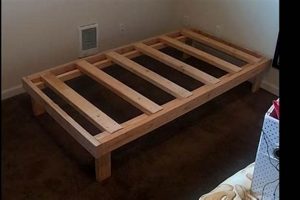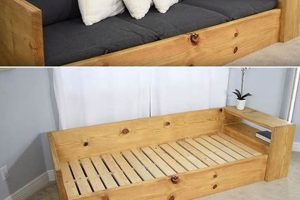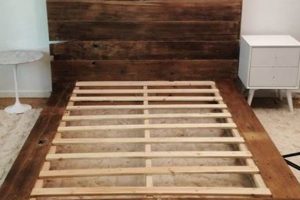A structural support, often crafted from metal or wood, serves as the foundation for a self-constructed lighting fixture intended to be suspended from a ceiling. Such frameworks provide the armature upon which decorative elements, wiring, and light sources are affixed to create a personalized illumination device. An example would be a circular metal ring with radiating spokes designed to hold crystals and bulbs.
This foundational element empowers individuals to create unique and cost-effective lighting solutions tailored to specific aesthetic preferences and spatial requirements. Historically, individuals repurposed existing structures, adapting them to support custom lighting designs. This practice allowed for personalization not readily available through mass-produced alternatives, contributing to unique interior design expressions.
The subsequent sections will explore diverse approaches to creating this structural component, detailing materials, techniques, and safety considerations relevant to successful construction. These discussions will also cover design variations and suitable applications within various interior settings.
Construction Guidance
The following guidance aims to inform the construction process, promoting safe and effective creation of the foundational element.
Tip 1: Material Selection. Choose materials commensurate with the intended load and aesthetic. Metal, typically steel or wrought iron, offers durability and structural integrity. Wood provides a lighter, more easily workable alternative, though load-bearing capacity is reduced.
Tip 2: Structural Integrity. Employ appropriate joining techniques. Welding offers a permanent, robust connection for metal frameworks. Wood frameworks benefit from the use of screws and adhesives rated for structural applications.
Tip 3: Weight Distribution. Design the framework to distribute weight evenly. Uneven distribution can lead to structural failure and potential hazard. Consider the placement of light sources and decorative elements during the design phase.
Tip 4: Electrical Considerations. Plan for wiring pathways. Integrate channels or supports within the framework to accommodate electrical wiring. Ensure wiring is properly insulated and secured to prevent chafing or damage.
Tip 5: Safety Certification. Prioritize safety. Consult with a qualified electrician regarding electrical safety standards and appropriate wiring gauges. Ensure compliance with local building codes related to lighting fixtures.
Tip 6: Finishing Techniques. Apply appropriate finishes to protect materials and enhance aesthetics. Metal frameworks benefit from rust-inhibiting paints or powder coatings. Wood frameworks can be stained, painted, or sealed.
Tip 7: Dimensional Accuracy. Maintain precise measurements. Accurate dimensions are critical for structural integrity and visual appeal. Utilize accurate measuring tools and techniques throughout the construction process.
Successful construction requires careful planning, precise execution, and a commitment to safety standards. These considerations ensure the creation of a durable, visually appealing, and safe lighting fixture.
The concluding sections will delve into advanced design techniques and methods for integrating the finished product within a broader design context.
1. Dimensions
The dimensions of a structural component are critically intertwined with its function and stability. The size, specifically diameter or length and width, directly impacts the lighting fixture’s suitability for a given space. A frame too large overwhelms a room, while an undersized one appears insignificant. Correct dimensional planning ensures visual harmony and prevents aesthetic imbalance within the environment. For example, a frame intended for a grand foyer demands a larger diameter than one destined for a smaller dining area. These specifications must be considered and decided before you design and build the diy chandelier frame.
Beyond aesthetics, dimensions dictate the load-bearing capacity. A larger diameter, if not properly supported, may be prone to bending or collapse under the weight of attached components such as crystals, lights, or shades. Frame element thickness and material properties must be calculated in direct relation to size. Consider the effect of larger diameters will increase the weight of the frame itself that would affect the installation method. A frame that is 2 feet will be lighter than the frame that is 5 feet, it would need a sturdier mounting bracket.
In summary, dimensional accuracy is paramount to the creation of safe, functional, and visually pleasing lighting fixtures. The selection of appropriate dimensions necessitates a careful consideration of spatial context, material properties, and weight distribution. These considerations directly influence the structural integrity and aesthetic impact of the final assembled piece.
2. Materials
Material selection is paramount in the creation of a structurally sound and aesthetically pleasing foundational element for a lighting fixture. The choice of materials directly influences the durability, weight, aesthetic character, and safety of the finished piece. Careful consideration must be given to the properties of each material in relation to its intended function.
- Metal Alloys
Metal alloys, such as steel, wrought iron, and aluminum, provide high tensile strength and durability, making them suitable for frames that must support significant weight. Steel offers robustness but can be prone to corrosion; wrought iron provides a traditional aesthetic with enhanced corrosion resistance; aluminum is lightweight and corrosion-resistant but may require thicker gauges for equivalent strength. The selection depends on aesthetic preference, environmental conditions, and load-bearing requirements.
- Wood
Wood offers a lightweight and easily workable alternative to metal. Hardwoods like oak and maple provide superior strength and durability compared to softwoods like pine. Wood frames are often favored for their natural aesthetic and ease of shaping and finishing. However, wood is susceptible to moisture damage, insect infestation, and flammability, necessitating appropriate treatments and precautions. Real-world examples include rustic, farmhouse-style lighting fixtures, and those with intricate carved details.
- Plastics and Polymers
Plastics and polymers offer versatility in shape, color, and texture. They are lightweight, corrosion-resistant, and relatively inexpensive. However, their structural strength is generally lower than that of metal or wood, limiting their use to lighter-weight decorative elements or smaller frames. Examples include acrylic and polycarbonate, which can be molded into complex shapes and offer varying degrees of transparency. When wiring lights, consider heat resistance and flame retardancy ratings.
- Composites
Composite materials, such as fiberglass and carbon fiber, combine the properties of different materials to achieve enhanced strength-to-weight ratios. Fiberglass is commonly used in applications requiring high strength and corrosion resistance, while carbon fiber offers exceptional strength and stiffness but is typically more expensive. These materials allow for the creation of lightweight yet robust frames, suitable for contemporary designs. Consider the cost and complexity of working with these materials.
The judicious selection of materials forms the basis for a successful construction. The appropriate choice enhances structural integrity, determines aesthetic character, and ensures safety. Each material presents unique advantages and limitations that must be carefully evaluated within the context of design objectives and functional requirements. Consideration of weight distribution, wiring accessibility, and compliance with safety standards are integral to the material selection process.
3. Weight capacity
Weight capacity constitutes a critical parameter in the design and construction of a self-assembled lighting fixture support structure. The potential for catastrophic failure exists if the framework cannot adequately support the combined mass of its components, including the frame itself, decorative elements (crystals, glass, shades), and electrical components (light bulbs, wiring). Therefore, structural design must begin with a precise determination of the total anticipated weight. This determination directly informs material selection, joint construction techniques, and suspension methods.
An insufficient load-bearing assessment can lead to several adverse outcomes. Overloading a wooden frame, for example, may result in sagging or fracturing of the wood, potentially causing the fixture to detach from its mounting. Similarly, using under-gauged metal may cause bending or complete structural failure under sustained load. A real-world illustration involves a homeowner who used repurposed, lightweight aluminum tubing to create a large, multi-tiered support structure. Upon installation, the frame exhibited significant deformation under the weight of the added crystals, necessitating a complete reconstruction with heavier-gauge steel. The appropriate weight capacity of the diy chandelier frame is therefore a function of the materials you use, the dimensions, and the design.
In conclusion, accurate estimation of weight and the selection of materials and construction techniques that provide adequate load-bearing capabilities are non-negotiable aspects of any diy chandelier frame project. Overlooking this vital consideration introduces significant safety risks and jeopardizes the long-term integrity of the fixture. Prioritizing structural integrity through proper planning and execution is essential for a safe and successful outcome.
4. Wiring pathways
Wiring pathways represent an integral, often overlooked, aspect of any self-assembled lighting fixture support structure. The absence of a well-defined and properly executed system for routing electrical conductors creates significant safety hazards and impedes functionality. Improperly managed wiring can lead to short circuits, overheating, and even electrical fires. Therefore, from the initial design phase, a plan for safely and efficiently integrating wiring into the structural frame must be developed.
The design of wiring pathways should consider several factors. The gauge and type of wire, determined by the current load of the lighting elements, dictate the necessary space for conduit or channels within the frame. Sharp edges or corners in the frame can damage insulation, so smooth, rounded transitions are essential. Furthermore, the pathway must allow for easy access to wiring for maintenance and repairs, eliminating the need to disassemble the entire fixture. A practical example involves a homeowner constructing a chandelier frame from reclaimed wood. Without pre-planning for wiring, they resorted to drilling holes haphazardly, resulting in compromised structural integrity and difficult, unsafe wire routing. This necessitated significant rework and highlighted the importance of integrating wiring considerations from the outset.
In summary, meticulous planning and execution of wiring pathways are crucial for the safety and functionality of a self-constructed lighting fixture. Integrating wiring considerations into the initial design prevents potential hazards, facilitates maintenance, and ensures long-term reliability. Neglecting this aspect can compromise the structural integrity of the framework and pose significant electrical risks. Successful implementation relies on thoughtful design, careful material selection, and adherence to established electrical safety standards. The careful planning of the wiring pathways would ensure the safety of the diy chandelier frame.
5. Aesthetic Integration
Aesthetic integration, concerning a self-constructed lighting fixture, represents the harmonious blending of the structural framework with the surrounding environment. A poorly considered framework, despite its structural soundness, can visually clash with the interior design, diminishing the overall aesthetic appeal of the space. Conversely, a thoughtfully designed frame complements the room’s existing style, enhancing its visual coherence and creating a unified aesthetic experience. The selection of materials, finishes, and overall design should align with the architectural style, color palette, and decorative elements present within the room. For instance, a rustic wooden frame might be suitable for a farmhouse-style setting, while a sleek metal frame would better complement a modern, minimalist space. The choice of the frame should enhance the effect and mood that diy chandelier frame are to give.
Successful integration involves a meticulous consideration of scale, proportion, and form. The size of the frame should be commensurate with the dimensions of the room, avoiding visual dominance or insignificance. The proportions of the frame, including the ratio of height to width and the arrangement of its components, should be visually pleasing and balanced. The form of the frame, whether geometric, organic, or abstract, should resonate with the existing design language of the space. A practical application of this principle involves a homeowner who meticulously matched the metal finish of their self-built frame to the existing hardware in their dining room, creating a cohesive and unified visual statement.
In conclusion, aesthetic integration is not merely an afterthought but a fundamental element in the creation of a visually successful lighting fixture. Failure to address this aspect can undermine the overall design and diminish the intended impact of the fixture. Achieving harmonious integration requires careful consideration of materials, scale, proportion, form, and their interrelationship with the surrounding environment. The diy chandelier frame must therefore harmonize with the surrounding, or the value of the frame will decrease in value.
6. Suspension method
The method of suspension is intrinsically linked to the design and construction of a self-made lighting fixture support structure. The means by which the frame is affixed to the ceiling or supporting structure directly influences its stability, safety, and overall aesthetic presentation. The chosen suspension method must be capable of supporting the entire weight of the frame and its components while also accommodating electrical wiring and complying with local building codes. A failure to adequately address suspension can result in structural failure, electrical hazards, and an unappealing aesthetic outcome. For example, a frame relying on a single, inadequately rated chain for suspension risks detachment and potential injury. Similarly, a poorly concealed wiring system detracts from the fixture’s visual appeal.
Practical considerations for suspension methods include chain, cable, rod, and direct mounting. Chain offers adjustability and a traditional aesthetic, requiring appropriately rated links and secure attachment points. Cable provides a more modern and minimalist look, demanding specialized hardware for secure fastening and load distribution. Rods offer rigidity and a clean appearance, necessitating precise measurements and robust mounting. Direct mounting, where the frame is directly affixed to the ceiling, is suitable for lightweight frames but requires careful consideration of ceiling structure and weight distribution. The correct approach will depend on the diy chandelier frame.
In conclusion, the selection and implementation of a suspension method are critical components of a successful self-constructed lighting fixture project. Prioritizing safety, stability, and aesthetic integration ensures a durable, visually appealing, and compliant installation. Overlooking this aspect can compromise the entire project, resulting in potential hazards and an unsatisfactory outcome. The suspension method is not merely an attachment point but an integral design element that demands careful consideration and meticulous execution. The diy chandelier frame would benefit greatly from carefully considered method.
7. Code Compliance
Adherence to established electrical and building regulations is a mandatory component in any self-constructed lighting fixture, regardless of its aesthetic appeal or functional design. Electrical codes, often national or regional in scope, dictate safety standards for wiring, insulation, grounding, and fixture installation. Building codes address structural safety, including load-bearing capacity and proper mounting techniques. Failure to comply with these codes presents significant risks, ranging from electrical shock and fire hazards to structural collapse. For example, many electrical codes mandate the use of specific wire gauges based on amperage, thereby preventing overheating and potential fires. A self-constructed frame that uses inappropriately sized wiring, even if aesthetically pleasing, poses a clear and present danger.
The practical implications of code compliance extend beyond immediate safety. Many jurisdictions require inspections of electrical work, including lighting fixture installations. A self-constructed frame that does not meet code requirements will fail inspection, necessitating costly rework or complete removal. Furthermore, non-compliant installations may void homeowners’ insurance policies in the event of an electrical fire or other related incident. Local codes also often specify permissible distances between lighting fixtures and combustible materials, further emphasizing the need for careful planning and adherence to regulations. In practice, this means a builder of a diy chandelier frame has to take note of the specifications so that they may use them during the build to meet the code of compliance.
In conclusion, code compliance is not a mere formality but a fundamental requirement for ensuring the safety and legality of a self-constructed lighting fixture. Ignoring these regulations introduces unacceptable risks and potential legal ramifications. Builders must familiarize themselves with all applicable codes and standards and implement them rigorously throughout the design and construction process. The safety of the installation, and potentially the building’s occupants, depends on it. Any diy chandelier frame that fails to meet code, is a danger and hazard.
Frequently Asked Questions
The following addresses common inquiries regarding the design, construction, and safety considerations related to homemade structural supports for suspended lighting devices.
Question 1: What materials are most suitable for constructing a stable and durable foundational structure?
Metal alloys, such as steel or wrought iron, offer high tensile strength and are suitable for frames supporting significant weight. Wood provides a lighter, more easily workable alternative, though hardwoods like oak or maple are preferred for increased durability. The selection depends on aesthetic preference and load-bearing requirements.
Question 2: How is the weight capacity of a structural component accurately determined?
The weight capacity must account for the combined mass of the frame itself, decorative elements (crystals, glass), and electrical components (light bulbs, wiring). Structural calculations should be performed to ensure the selected materials and construction techniques can safely support the anticipated load.
Question 3: What are the critical considerations when designing wiring pathways within the structure?
Wiring pathways must accommodate the gauge and type of wire, provide smooth transitions to prevent insulation damage, and allow for easy access for maintenance. Proper planning and execution are crucial for preventing electrical hazards and ensuring long-term reliability.
Question 4: How can a structural component be aesthetically integrated into an existing interior design?
Aesthetic integration involves aligning the materials, finishes, and overall design of the frame with the architectural style, color palette, and decorative elements present in the room. Consideration of scale, proportion, and form is essential for creating a unified aesthetic experience.
Question 5: What are the recommended methods for suspending a structural component from a ceiling?
Suitable suspension methods include chain, cable, rod, and direct mounting. The chosen method must be capable of supporting the entire weight of the frame and its components while also accommodating electrical wiring and complying with local building codes. Safety is paramount.
Question 6: What codes and regulations must be adhered to when constructing a structural component for a lighting fixture?
Electrical codes dictate safety standards for wiring, insulation, and grounding. Building codes address structural safety, including load-bearing capacity and mounting techniques. Compliance with these codes is essential for ensuring safety and avoiding legal ramifications.
The information presented addresses critical aspects of framework construction, emphasizing structural integrity, safety, and aesthetic considerations.
The subsequent article sections will provide detailed guidance on specific construction techniques and design variations.
Conclusion
The preceding exploration of the foundational support underscores its crucial role in achieving safe, functional, and aesthetically pleasing lighting. Key elements include material selection, weight capacity assessment, careful wiring pathway design, aesthetic integration, secure suspension methods, and strict code compliance. A successful construction project hinges on a comprehensive understanding and application of these principles.
The responsible creation of a self-constructed luminaire necessitates a commitment to both structural integrity and electrical safety. Future endeavors should prioritize the rigorous application of engineering principles and adherence to all applicable regulations, ensuring that the resultant lighting fixtures are both beautiful and safe for their intended environment.







